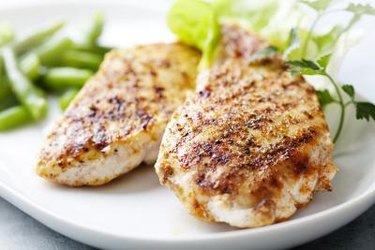
Grilled chicken breast is a summer time favorite, served plain or slathered in barbecue sauce. Its versatility makes this meat useful in the kitchen as well; not only does grilled chicken breast serve as a high quality protein source by itself, you can add it to salads and casseroles to boost the nutritional value.
Do you want to lose weight or be healthier? Join MyPlate Calorie Counter and get access to free meal plans, healthy recipes and at-home workouts. You'll also get daily calorie and macro goals for your fitness journey. Don't miss your chance for amazing results. Sign up today!
Video of the Day
Video of the Day
Calories and Serving Size
The calories in a 4-oz chicken breast amounts to 171 calories, although any sauces or marinades you use on the chicken will add to the calorie count. No need to drag out your food scale to measure out a 4-oz. portion: this serving size of grilled chicken breast is approximately the size of the palm of your hand. Chicken has no carbohydrates or fiber.
Fat Content
A 4-oz. serving of grilled chicken breast has 3.6 grams (g) of fat, of which 1.1 g is saturated fat, according to USDA National Nutrient Database. Your daily fat intake should range from 20 to 35 percent of your total calories, depending on your gender and age, according to USDA Dietary Guidelines. Keep fat consumption within that spectrum to avoid weight gain and related health problems.
A Good Source of Protein
Eat a 4-oz. portion of grilled chicken breast and you contribute 35 g of protein to your meal plan. The recommended daily allowance is 46 g for adult females and 56 g for adult men, according to USDA. Like all animal proteins, grilled chicken breast is a complete protein, containing all the amino acids your body needs to function. Protein is a vital component of every cell in your body and is required for building muscle and repairing tissue.
Read More: How Much Protein Does Meat Have?
Benefits of B Vitamins
Chicken breast is an excellent source of B vitamins which provide many health benefits for your body. With a niacin content of 14 milligrams (mg), one 4-oz serving supplies 100 percent of the daily recommendation for adult women and 90 percent RDA for men, according to the recommendations on MedlinePlus.
Niacin provides your body with energy and aids in nerve function and your digestive system. Grilled chicken also is a rich source of vitamin B-6, with 1.3 mg, providing 100 percent RDA. Vitamin B-6 is essential for formation of red blood cells and helps keep skin healthy, says Merck Manual. Other B vitamins contributing to grilled chicken breast nutrition include thiamin, riboflavin and vitamin B-12.
An Abundance of Minerals
Grilled chicken breast contains 6 mg of calcium to help your muscles contract and your blood to clot. Calcium works with phosphorus in chicken —292 mg per 4-oz — to help build strong bones and teeth.
One serving of grilled chicken breast provides .5 mg of iron, a component of hemoglobin. Along with the 443 mg of potassium in chicken, it provides the ability for blood to carry oxygen and conduct electrical charges between cells to keep your organs functioning properly, says the National Institutes of Health. Chicken breast also contains zinc, which supports your immune system.
High Cholesterol Content
Grilled chicken breast contains a significant amount of cholesterol with 118 mg per 4 oz. You need cholesterol to help with digestion, and make hormones and vitamin D. Your body makes all the cholesterol it needs so excess from food often takes up residence in your arteries, building up and eventually blocking blood flow.
According to the American Heart Association, although there are no specific recommended limits for the amount of cholesterol you consume from food, it's still important to keep your body's cholesterol levels in a healthy range.
Read More: Cholesterol Health
- USDA Dietary Guidelines 2015-2020
- National Institutes of Health: Iron
- USDA National Nutrient Database: Chicken, Broiler or Fryers, Breast, Skinless, Boneless, Meat Only, Cooked, Grilled
- MedlinePlus: Niacin
- Merck Manual: Vitamin B-6
- The Nutritional Value of Chicken
- American Heart Association: Common Misconceptions about Cholesterol